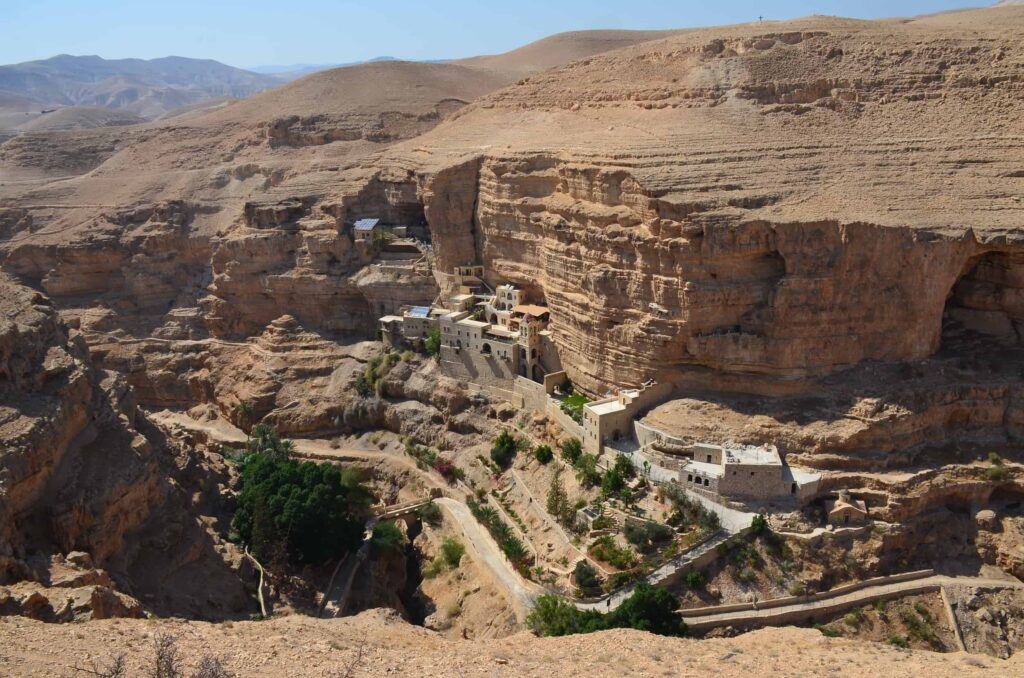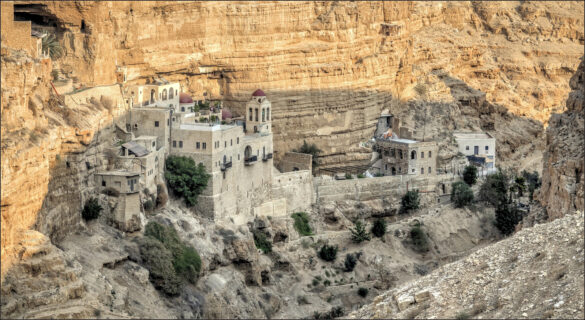Nestled in the rugged cliffs of the Wadi Qelt in the Judaean Desert, the Monastery of Saint George of Choziba stands as a remarkable testament to faith, history, and perseverance. Also known simply as the St. George Monastery, this ancient Greek Orthodox monastery is a place where spirituality meets breathtaking natural beauty. Perched dramatically above the desert valley, it has served as a sanctuary for monks, pilgrims, and travelers seeking solitude and reflection for centuries. Visiting the monastery offers an extraordinary glimpse into the religious, historical, and natural heritage of the Judaean Desert.

Historical Background
The Monastery of Saint George of Choziba has a history that stretches back over 1,500 years. It was originally founded in the 5th century during the Byzantine period, a time when Christian monasticism was flourishing in the deserts of the Holy Land. The site was chosen for its seclusion, dramatic cliffs, and proximity to Wadi Qelt, which provided water, shelter, and natural protection.
The monastery takes its name from Saint George of Choziba, a monk who lived during the early Byzantine era and was revered for his piety, asceticism, and dedication to monastic life. According to tradition, Saint George and other monks established a community here, devoting themselves to prayer, meditation, and manual labor while living in isolation from the outside world.
Over the centuries, the monastery faced periods of decline due to invasions, earthquakes, and political instability. It was abandoned at times but always restored by devoted monks and benefactors who recognized its spiritual and historical significance. Today, it remains a functioning monastery under the Greek Orthodox Patriarchate of Jerusalem, welcoming both pilgrims and tourists.
Location and Natural Setting
The monastery is located in Wadi Qelt, a stunning desert canyon that stretches from Jericho to Jerusalem. The wadi is characterized by steep cliffs, narrow gorges, and the perennial Qelt stream, which sustains the surrounding flora and wildlife. The monastery itself is perched roughly 300 meters above the valley floor, making it a dramatic sight visible from far below.
The location was strategically chosen for both spiritual and practical reasons. The desert offered solitude and tranquility, essential for monastic life, while the valley provided access to fresh water, shade, and arable land. The natural beauty of Wadi Qelt—its cliffs, caves, and desert flora—adds to the monastery’s serene and contemplative atmosphere.
Hiking trails to the monastery provide panoramic views of the Judaean Desert, the Dead Sea region, and the distant hills of Jerusalem. For nature lovers, photographers, and pilgrims alike, the journey through the canyon is as rewarding as the destination itself.
Architecture and Layout
The architecture of the Monastery of Saint George of Choziba reflects centuries of construction, restoration, and adaptation. The monastery is built into the cliff face, with stone buildings, terraces, and stairways seamlessly integrated into the natural landscape.
Key features of the monastery include:
- The Main Church (Katholikon): Adorned with icons, frescoes, and religious artifacts, it serves as the center for communal worship and daily prayers.
- Monastic Cells: Simple living quarters for monks, often carved into the cliffs, reflecting the ascetic lifestyle of the community.
- Guest Rooms: Small accommodations for pilgrims and visitors, providing a quiet space for reflection.
- Chapel of Saint George: Dedicated to the monastery’s patron saint, this chapel houses relics and serves as a focal point for pilgrimage.
- Terraces and Gardens: Small cultivated areas used for growing vegetables, herbs, and flowers, demonstrating the monks’ self-sufficiency and connection to the land.
The monastery’s construction demonstrates remarkable engineering, as the buildings are supported by stone foundations carved into cliffs and reinforced to withstand the region’s earthquakes and flash floods. The blend of natural and man-made elements creates a harmonious and inspiring setting for contemplation.
Spiritual and Religious Significance
The Monastery of Saint George of Choziba holds deep spiritual importance for the Greek Orthodox community and for Christians worldwide. It is considered a place of prayer, pilgrimage, and ascetic practice, where monks dedicate their lives to spiritual growth, worship, and service.
Pilgrims visit the monastery to pray, attend liturgical services, and seek guidance from the resident monks. The monastery is especially significant during religious festivals such as Easter, when pilgrims participate in processions and special services.
The monastery is also linked to several biblical and religious traditions. Wadi Qelt, where it is located, is often associated with the route taken by the prophet Elijah, as well as with early Christian monastic settlements described in historical texts. This connection to biblical history enhances the monastery’s spiritual aura, making it a site of reflection and reverence.
Life at the Monastery
Life at the Monastery of Saint George of Choziba is governed by the rhythm of prayer, work, and contemplation. Monks follow a strict daily schedule that includes:
- Early morning prayers and chanting
- Manual labor, including gardening, maintenance, and cooking
- Study of religious texts and iconography
- Hospitality to visitors and pilgrims
The ascetic lifestyle emphasizes simplicity, humility, and devotion. Monks often live in solitude within their cliffside cells, emerging for communal prayers and work. This lifestyle, preserved over centuries, offers visitors a glimpse into a world largely unchanged since the Byzantine era.
Visiting the Monastery
Visiting the Monastery of Saint George of Choziba is a journey that combines spiritual reflection, historical exploration, and natural beauty. Some tips for visitors include:
- Hiking Access: The monastery can be reached by a well-marked hiking trail through Wadi Qelt. The hike is moderately challenging, requiring sturdy footwear, water, and sun protection.
- Guided Tours: Local guides provide historical context, explain monastic life, and highlight the monastery’s architectural and religious features.
- Respectful Attire: Visitors are expected to dress modestly, covering shoulders and knees, in respect of the monastery’s religious customs.
- Photography: Allowed in most areas, but visitors should avoid photographing monks during private prayers.
The journey to the monastery, with its dramatic cliffs, desert flora, and panoramic views, is as much a part of the experience as the monastery itself. Many visitors describe the hike as meditative, offering time for reflection amid the natural and spiritual surroundings.
Conservation and Preservation
The Monastery of Saint George of Choziba has been carefully preserved over centuries, thanks to the dedication of monks, religious authorities, and heritage organizations. Restoration efforts focus on maintaining structural integrity, protecting frescoes and icons, and ensuring safe access for visitors.
Preservation is particularly important given the monastery’s location in a flash-flood-prone canyon and its exposure to earthquakes. Sustainable tourism practices, including guided access and visitor education, help protect the site while allowing people to experience its historical and spiritual significance.
The Monastery in Modern Times
Today, the Monastery of Saint George of Choziba continues to serve as a spiritual sanctuary, attracting pilgrims, tourists, and hikers from around the world. It has gained recognition not only for its religious importance but also for its cultural, historical, and natural value.
Modern visitors often combine a visit to the monastery with exploration of nearby sites, such as:
- Wadi Qelt hiking trails
- Ein Gedi Nature Reserve, known for waterfalls and wildlife
- Jericho, one of the oldest continuously inhabited cities in the world
- The Judaean Desert, for photography, reflection, and desert trekking
The monastery represents continuity, faith, and the endurance of tradition in a rapidly changing world. Its combination of natural beauty, historical depth, and spiritual significance makes it a must-visit destination in the Judaean Desert.
Final Reflections
The Monastery of Saint George of Choziba is more than an architectural marvel—it is a living testament to human devotion, resilience, and the quest for spiritual connection. Perched above the dramatic cliffs of Wadi Qelt, it has witnessed centuries of history, from Byzantine monks to modern pilgrims.
For visitors, the monastery offers a rare opportunity to step into a world where faith, history, and nature intersect. Hiking the canyon, exploring the cliffside buildings, and observing monastic life fosters a deep sense of reflection and appreciation for both the natural and spiritual landscapes.
In a world often marked by distraction and pace, the Monastery of Saint George of Choziba stands as a sanctuary of contemplation, inviting all who visit to pause, reflect, and connect with something timeless. It is a hidden gem of the Judaean Desert, where history, faith, and beauty converge in a breathtaking and unforgettable setting.

